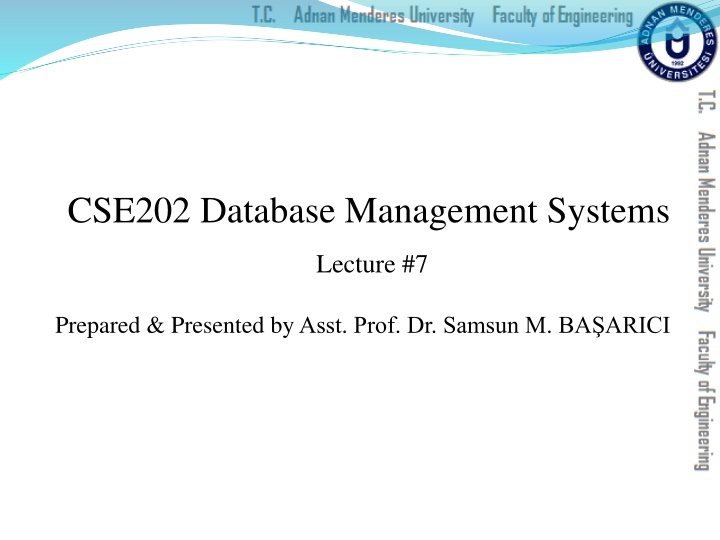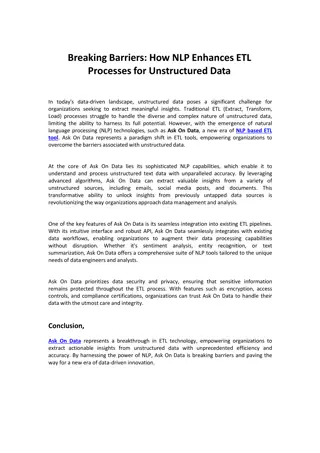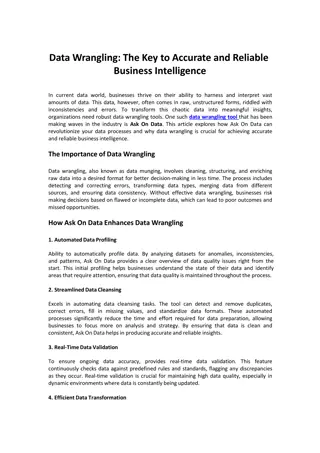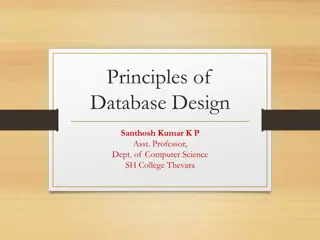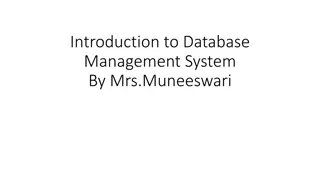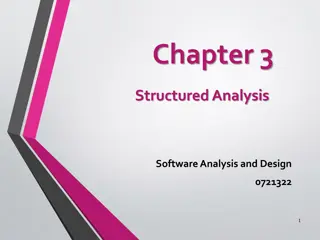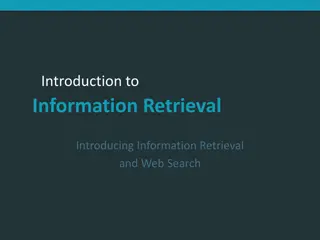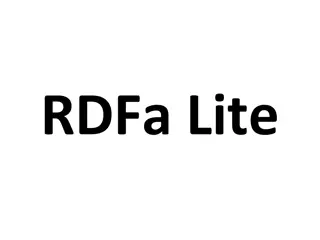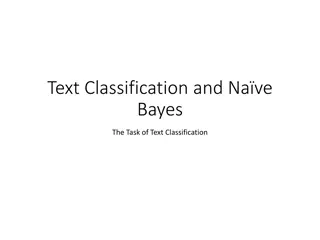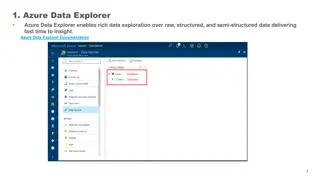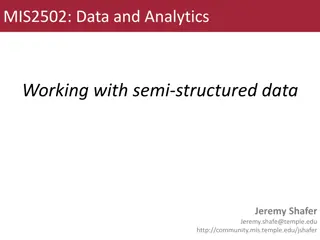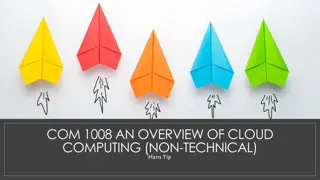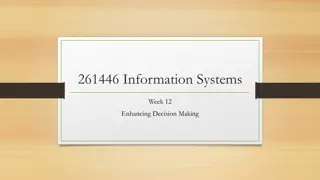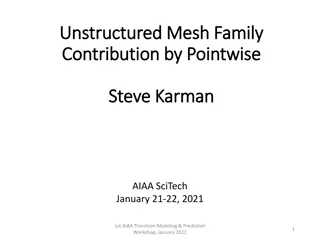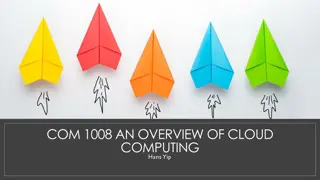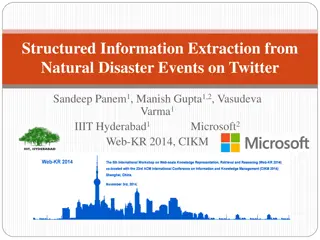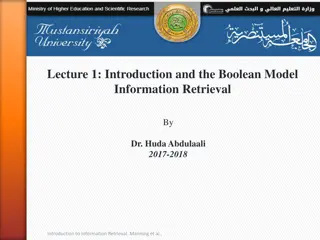Differentiating Structured, Semistructured, and Unstructured Data
"Dive into the world of data management with a focus on structured, semistructured, and unstructured data. Explore the XML hierarchical data model, document structures, and the use of XML languages in databases. Discover the nuances of database programming techniques and compare approaches in database stored procedures. Uncover the diverse aspects of schema information mixed with data values and self-describing data presentations."
Download Presentation

Please find below an Image/Link to download the presentation.
The content on the website is provided AS IS for your information and personal use only. It may not be sold, licensed, or shared on other websites without obtaining consent from the author.If you encounter any issues during the download, it is possible that the publisher has removed the file from their server.
You are allowed to download the files provided on this website for personal or commercial use, subject to the condition that they are used lawfully. All files are the property of their respective owners.
The content on the website is provided AS IS for your information and personal use only. It may not be sold, licensed, or shared on other websites without obtaining consent from the author.
E N D
Presentation Transcript
CSE202 Database Management Systems Lecture #7 Prepared & Presented byAsst. Prof. Dr. Samsun M. BA ARICI
Learning Objectives Differentiate between structured, semistructured, and unstructured data Understand the XML hierarchical (tree) data model Understand XML documents, DTD, and XML schema Store and extract XML documents from databases Understand and use XML languages Extract XML documents from relational databases Understand database programming techniques and related issues Differentiate between embedded SQL, dynamic SQL, and SQLJ Apply database programming with function calls: SQL/CLI and JDBC Implement database stored procedures and SQL/PSM Compare the three approaches 2
Outline Structured, Semistructured, and Unstructured Data XML Hierarchical (Tree) Data Model XML Documents, DTD, and XML Schema Storing and Extracting XML Documents from Databases XML Languages Extracting XML Documents from Relational Databases Database Programming: Techniques and Issues Embedded SQL, Dynamic SQL, and SQLJ Database Programming with Function Calls: SQL/CLI and JDBC Database Stored Procedures and SQL/PSM Comparing the Three Approaches 3
Part 1 XML: Extensible Markup Language 4
XML: Extensible Markup Language Data sources Database storing data for Internet applications Hypertext documents Common method of specifying contents and formatting of Web pages XML data model 5
Structured, Semistructured, and Unstructured Data Structured data Represented in a strict format Example: information stored in databases Semistructured data Has a certain structure Not all information collected will have identical structure 6
Structured, Semistructured, and Unstructured Data (cont.) Schema information mixed in with data values Self-describing data May be displayed as a directed graph Labels or tags on directed edges represent: Schema names Names of attributes Object types (or entity types or classes) Relationships 7
Structured, Semistructured, and Unstructured Data (cont.) Unstructured data Limited indication of the of data document that contains information embedded within it HTML tag Text that appears between angled brackets: <...> End tag Tag with a slash: </...> 9
Structured, Semistructured, and Unstructured Data (cont.) HTML uses a large number of predefined tags HTML documents Do not include schema information about type of data Static HTML page All information to be displayed explicitly spelled out as fixed text in HTML file 10
XML Hierarchical (Tree) Data Model Elements and attributes Main structuring concepts used to construct an XML document Complex elements Constructed from other elements hierarchically Simple elements Contain data values XML tag names Describe the meaning of the data elements in the document 12
XML Hierarchical (Tree) Data Model (cont.) Treemodel or hierarchical model Main types of XML documents Data-centric XML documents Document-centric XML documents Hybrid XML documents Schemaless XML documents Do not follow a predefined schema of element names and corresponding tree structure 14
XML Hierarchical (Tree) Data Model (cont.) XML attributes Describe properties and characteristics of the elements (tags) within which they appear May reference another element in another part of the XML document Common to use attribute values in one element as the references 15
XML Documents, DTD, and XML Schema Well formed Has XML declaration Indicates version of XML being used as well as any other relevant attributes Every element must matching pair of start and end tags Within start and end tags of parent element DOM (Document Object Model) Manipulate resulting tree representation corresponding to a well-formed XML document 16
XML Documents, DTD, and XML Schema (cont.) SAX (Simple API for XML) Processing of XML documents on the fly Notifies processing program through callbacks whenever a start or end tag is encountered Makes it easier to process large documents Allows for streaming 17
XML Documents, DTD, and XML Schema (cont.) Valid Document must be well formed Document must follow a particular schema Start and end tag pairs must follow structure specified in separate XML DTD (Document Type Definition) file or XML schema file 18
XML Documents, DTD, and XML Schema (cont.) Notation for specifying elements XML DTD Data types in DTD are not very general Special syntax Requires specialized processors All DTD elements always forced to follow the specified ordering of the document Unordered elements not permitted 19
XML Schema XML schema language Standard for specifying the structure of XML documents Uses same syntax rules as regular XML documents Same processors can be used on both 20
XML Schema (cont.) Identify specific set of XML schema language elements (tags) being used Specify a file stored at a Web site location XML namespace Defines the set of commands (names) that can be used 22
XML Schema (cont.) XML schema concepts: Description and XML namespace Annotations, documentation, language Elements and types First level element Element types, minOccurs, and maxOccurs Keys Structures of complex elements Composite attributes 23
Storing and Extracting XML Documents from Databases Most common approaches Using a DBMS to store the documents as text Can be used if DBMS has a special module for document processing Using a DBMS to store document contents as data elements Require mapping algorithms to design a database schema that is compatible with XML document structure 24
Storing and Extracting XML Documents from Databases (cont.) Designing a specialized system for storing native XML data Called Native XML DBMSs Creating or publishing customized XML documents from preexisting relational databases Use a separate middleware software layer to handle conversions 25
XML Languages Two query language standards XPath Specify path expressions to identify certain nodes (elements) or attributes within an XML document that match specific patterns XQuery Uses XPath expressions but has additional constructs 26
XPath: Specifying Path Expressions in XML XPath expression Returns a sequence of items that satisfy a certain pattern as specified by the expression Either values (from leaf nodes) or elements or attributes Qualifier conditions Further restrict nodes that satisfy pattern Separators used when specifying a path: Single slash (/) and double slash (//) 27
XPath: Specifying Path Expressions in XML (cont.) Attribute name prefixed by the @ symbol Wildcard symbol * Stands for any element Example: /company/* 29
XPath: Specifying Path Expressions in XML (cont.) Axes Move in multiple directions from current node in path expression Include self, child, descendent, attribute, parent, ancestor, previous sibling, and next sibling 30
XPath: Specifying Path Expressions in XML (cont.) Main restriction of XPath path expressions Path that specifies the pattern also specifies the items to be retrieved Difficult to specify certain conditions on the pattern while separately specifying which result items should be retrieved 31
XQuery: Specifying Queries in XML XQuery FLWR expression Four main clauses of XQuery Form: FOR <variable bindings to individual nodes (elements)> LET <variable bindings to collections of nodes (elements)> WHERE <qualifier conditions> RETURN <query result specification> Zero or more instances of FOR and LET clauses 32
XQuery: Specifying Queries in XML (cont.) XQuery contains powerful constructs to specify complex queries www.w3.org Contains documents describing the latest standards related to XML and XQuery 34
Other Languages and Protocols Related to XML Extensible Stylesheet Language (XSL) Define how a document should be rendered for display by a Web browser Extensible Stylesheet Language for Transformations (XSLT) Transform one structure into different structure Web Services Description Language (WSDL) Description of Web Services in XML 35
Other Languages and Protocols Related to XML (cont.) Simple Object Access Protocol (SOAP) Platform-independent and programming language- independent protocol for messaging and remote procedure calls Resource Description Framework (RDF) Languages and tools for exchanging and processing of meta-data (schema) descriptions and specifications over the Web 36
Extracting XML Documents from Relational Databases Creating hierarchical XML views over flat or graph-based data Representational issues arise when converting data from a database system into XML documents UNIVERSITY database example 37
Breaking Cycles to Convert Graphs into Trees Complex subset with one or more cycles Indicate multiple relationships among the entities Difficult to decide how to create the document hierarchies Can replicate the entity types involved to break the cycles 40
Other Steps for Extracting XML Documents from Databases Create correct query in SQL to extract desired information for XML document Restructure query result from flat relational form to XML tree structure Customize query to select either a single object or multiple objects into document 41
Part 2 SQL Programming 42
Introduction to SQL Programming Techniques Database applications Host language Java, C/C++/C#, COBOL, or some other programming language Data sublanguage SQL SQL standards Continually evolving Each DBMS vendor may have some variations from standard 43
Database Programming: Techniques and Issues Interactive interface SQL commands typed directly into a monitor Execute file of commands @<filename> Application programs or database applications Used as canned transactions by the end users access a database May have Web interface 44
Approaches to Database Programming Embedding database commands in a general-purpose programming language Database statements identified by a special prefix Precompiler or preprocessor scans the source program code Identify database statements and extract them for processing by the DBMS Called embedded SQL 45
Approaches to Database Programming (cont.) Using a library of database functions Library of functions available to the host programming language Application programming interface (API) Designing a brand-new language Database programming language designed from scratch First two approaches are more common 46
Impedance Mismatch Differences between database model and programming language model Binding for each host programming language Specifies for each attribute type the compatible programming language types Cursor or iterator variable Loop over the tuples in a query result 47
Typical Sequence of Interaction in Database Programming Open a connection to database server Interact with database by submitting queries, updates, and other database commands Terminate or close connection to database 48
Embedded SQL, Dynamic SQL, and SQLJ Embedded SQL C language SQLJ Java language Programming language called host language 49
Retrieving Single Tuples with Embedded SQL EXEC SQL Prefix Preprocessor separates embedded SQL statements from host language code Terminated by a matching END-EXEC Or by a semicolon (;) Shared variables Used in both the C program and the embedded SQL statements Prefixed by a colon (:) in SQL statement 50
